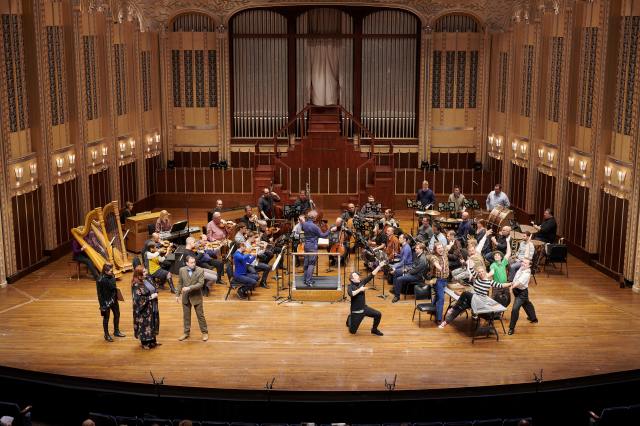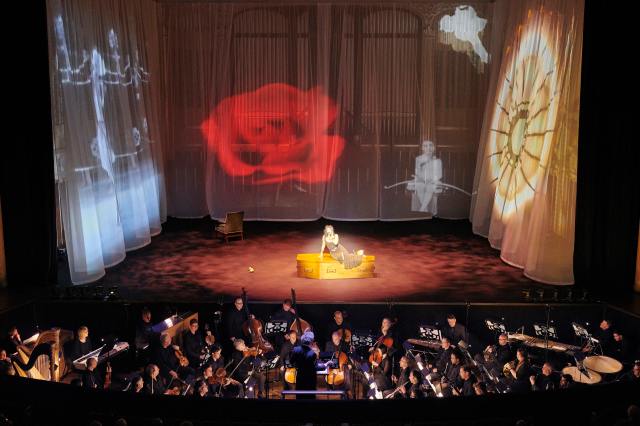Cleveland Orchestra
Franz Welser-Möst, conductor
Severance Hall
Cleveland, OH
January 13, 2019
Strauss: Ariadne auf Naxos, Op. 60
Tamara Wilson, soprano (Ariadne/Diva)
Andreas Schager, tenor (Bacchus/Tenor)
Daniela Fally, soprano (Zerbinetta)
Kate Lindsey, mezzo-soprano (Composer)
Wolfgang Brendel, speaking role (Major-Domo)
Hanno Müller-Brachmann, baritone (Music Master)
Jonas Hacker, tenor (Dance Master)
Julie Mathevet, soprano (Naiad)
Daryl Freedman, mezzo-soprano (Dryad)
Ying Fang, soprano (Echo)
Ludwig Mittelhammer, baritone (Harlequin)
James Kryshak, tenor (Scaramuccio)
Anthony Schneider, bass (Trufffaldino)
Miles Mykkanen, tenor (Brighella)
Frederic Wake-Walker, director
Alexander V. Nichols, lighting, projection, and set design
Dominic Robertson & Lottie Bowater, collage, animation, and video content design
Jason Southgate, costume design
Mallory Pace, hair and makeup design
In what has become an essential part of The Cleveland Orchestra’s Severance Hall season, music director Franz Welser-Möst led his ensemble in a staged opera production, this season turning attention towards Richard Strauss in Ariadne auf Naxos. A wholly unique work in the operatic canon, Ariadne is preceded by a prologue wherein a cast of characters plan and prepare an evening’s musical program, debating whether it should be serious art or comedic entertainment, and what follows is the resultant product – effectively, an opera with an opera. The new production was designed by Frederic Wake-Walker, who made much of Severance’s small stage and deftly incorporated motifs of the hall into his design.

Welser-Möst eschewed the usual conductor entrance, with the prologue opening practically in medias res with conductor and orchestra in casual dress as perhaps in the middle of a rehearsal: the musicians thus became characters themselves. The instrumental introduction evidenced the finely-tuned Strauss playing of this ensemble. Strauss scored it for the rather modest force of about 35, although owing to the composer’s mastery of orchestration it often sounded as much more. While the scoring was thinner in the winds – particularly given what one might expect for Strauss – it was fleshed out by three keyboard instruments (piano, harmonium, celeste), and the clear textures allowed for the solos of the Cleveland principals to be rendered in sharper focus – notable were passages from the flute, clarinet, oboe, cello, and concertmaster Peter Otto.
As the Major Domo, Wolfgang Brendel was both imposing and avuncular in his spoken role (the character purportedly being tone deaf), explaining to the Composer that the latter’s opera would coincide with a performance by a comedy troupe, setting up the prologue’s central conflict. Dressed in the glam of a rock star, Kate Lindsey brought enormous vigor and defiance to the firebrand Composer, scored for mezzo to portray his youth, which involved an artistic idealism he hardly wanted to yield to comedians. As the Prima Donna (and slated to play title role in the Composer’s opera), soprano Tamara Wilson captured the essence of the stereotypical diva (and incidentally, Wilson is to reprise the role with Welser-Möst at La Scala later this season). When it was announced an inflexibly scheduled fireworks display would necessitate the opera and the comedy to be performed simultaneously, the singers and the comics exchanged ideas in a humorous mashup of the comical and the serious.
After the prologue’s minimalist staging, Severance Hall underwent a miraculous transformation to host the opera proper. The orchestra was lowered down to the pit, and a curtain draped around the stage’s perimeter served as a canvas for a nearly continuous stream of video projection. In adoration of the production’s venue, patterns reflective of the Severance ceiling were displayed on the curtain, and Ariadne’s dress would invoke the same pattern. While I was impressed with the production being truly made for Cleveland, perhaps the sight lines of the hall could have further been considered during design – particularly in the prologue, some of the action was obscured from my vantage point on the side of the balcony.

Following another finely-played orchestral prelude, the celestial voices of the three nymphs were heard from above, reaching out to Wilson now refashioned as Ariadne. In a nod towards (somewhat) contemporaneous comedy, the comedians were costumed as the four Marx Brothers (is there any evidence that Strauss ever saw a Marx Brothers film?!). Additionally, clips from various comedies were projected, including scenes of Charlie Chaplin during the Harlequin’s aria, Lieben, Hassen, Hoffen, Zagen. Ludwig Mittelhammer gave a deeply lyrical and affecting reading of the Harlequin, and during his excellent pre-concert lecture, Prof. Bryan Gilliam observed that the aria in question bears a more than passing resemblance to the first movement theme from Mozart’s piano sonata K331 – a composer who Strauss profoundly admired.
The second half’s centerpiece, Zerbinetta’s extensive Großmächtige Prinzessin, saw Daniela Fally – donning a flapper dress – shining brilliantly in this coloratura tour de force. The ensemble piece Töne, töne, süße Stimme, given by the nymphs in concert with Ariadne, was of sublime beauty as well as another musical homage – in this case, to Schubert (the Wiegenlied, D498). Tenor Andreas Schager entered as Bacchus, stretching to the extremities of his vocal range with great power but always lyrical first and foremost. A transcendent transformation occurred on stage with the darkened hall becoming filled with light as Ariadne gave thought to life with Bacchus outside her cave on the titular Naxos, perhaps alluding to the quest for enlightenment in Plato’s allegory of the cave. Bacchus and Ariadne closed with a duet of luscious lyricism: in the wake of the earlier debates of high art vs. populism, the sublime firmly had the final word.

